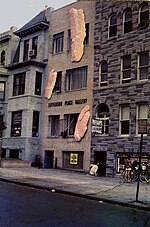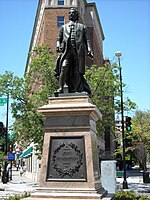Henry Wadsworth Longfellow Memorial

Henry Wadsworth Longfellow is a bronze statue, by William Couper, and Thomas Ball. The statue depicts American poet Henry Wadsworth Longfellow. It is located at the intersection of M Street and Connecticut Avenue, N.W. Washington, D.C., and was dedicated on May 7, 1909.After the death of Henry Wadsworth Longfellow in 1882, there were several plans to memorialize him. His bust was placed at Poets' Corner in Westminster Abbey in 1884 and a statue of the poet by Franklin Simmons was unveiled in his native town of Portland, Maine, at what became known as Longfellow Square. For the statue in Washington, an association was founded to raise money for the effort, ultimately earning $21,000 by subscribers. Additionally, Congress offered another $4,000 and the site. Members of the organization included Andrew Carnegie, Henry Cabot Lodge, Charles William Eliot, Edward Everett Hale, Julia Ward Howe, and Curtis Guild. Theodore Roosevelt served as Honorary Regent. It was unveiled in 1909 by the poet's granddaughter Erica Thorp in the presence of Chief Justice Melville Fuller and the United States Marine Band.
Excerpt from the Wikipedia article Henry Wadsworth Longfellow Memorial (License: CC BY-SA 3.0, Authors, Images).Henry Wadsworth Longfellow Memorial
18th Street Northwest, Washington
Geographical coordinates (GPS) Address Nearby Places Show on map
Geographical coordinates (GPS)
| Latitude | Longitude |
|---|---|
| N 38.905833333333 ° | E -77.041666666667 ° |
Address
18th Street Northwest 1208
20009 Washington
District of Columbia, United States
Open on Google Maps







